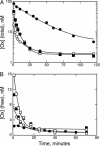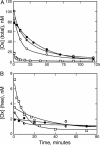Antibody buffering of a ligand in vivo
- PMID: 15615858
- PMCID: PMC544049
- DOI: 10.1073/pnas.0405797102
Antibody buffering of a ligand in vivo
Abstract
Clearance is the practical limit on drug action. Here we propose a means of slowing clearance, thereby extending drug lifetime in vivo by "antibody buffering." In this process, a drug and an anti-drug antibody are coadministered. Most of the drug is bound to the antibody, preventing the drug from acting, but also preventing its elimination. A dynamic free drug pool is established by reversible dissociation from the antibody. The free drug is active and can be eliminated, but the free pool is constantly replenished by reequilibration from the antibody-drug complex, giving a long effective lifetime. Here we explore antibody buffering experimentally by using a model compound, 2-phenyloxazol-5-one-gamma-aminobutyrate (Ox), as a drug proxy. We show that antibody buffering can extend by an order of magnitude the plasma lifetime of Ox in rats, and that the steady-state Ox level depends on the molecular properties of the antibody used to buffer the Ox. In addition, the anti-Ox antibody can be recharged with drug in vivo to extend Ox lifetime without additional antibody administration, making this technique even more suitable for possible clinical application.
Figures




Similar articles
-
Fine-specificity of the immune response to oxazolone. I. Contact sensitivity and early antibodies.J Immunol. 1981 Dec;127(6):2366-71. J Immunol. 1981. PMID: 7299129
-
Contact sensitization to oxazolone: involvement of both interferon-gamma and interleukin-4 in oxazolone-specific Ig and T-cell responses.Immunology. 1993 Feb;78(2):185-92. Immunology. 1993. PMID: 8473011 Free PMC article.
-
Anti-oxazolone hybridomas and strain distribution of the oxazolone idiotype.Scand J Immunol. 1983 Nov;18(5):421-7. doi: 10.1111/j.1365-3083.1983.tb00874.x. Scand J Immunol. 1983. PMID: 6606221
-
Structural implications of somatic mutations during the immune response to 2-phenyloxazolone.Res Immunol. 1994 Jan;145(1):41-5. doi: 10.1016/s0923-2494(94)80041-3. Res Immunol. 1994. PMID: 7516564 Review. No abstract available.
-
A new era for migraine: Pharmacokinetic and pharmacodynamic insights into monoclonal antibodies with a focus on galcanezumab, an anti-CGRP antibody.Cephalalgia. 2019 Sep;39(10):1284-1297. doi: 10.1177/0333102419840780. Epub 2019 Mar 27. Cephalalgia. 2019. PMID: 30917684 Free PMC article. Review.
Cited by
-
Interleukin-6 at the Host-Tumor Interface: STAT3 in Biomolecular Condensates in Cancer Cells.Cells. 2022 Mar 30;11(7):1164. doi: 10.3390/cells11071164. Cells. 2022. PMID: 35406728 Free PMC article. Review.
-
In Translation: FcRn across the Therapeutic Spectrum.Int J Mol Sci. 2021 Mar 17;22(6):3048. doi: 10.3390/ijms22063048. Int J Mol Sci. 2021. PMID: 33802650 Free PMC article. Review.
-
Dual Function pH Responsive Bispecific Antibodies for Tumor Targeting and Antigen Depletion in Plasma.Front Immunol. 2019 Aug 9;10:1892. doi: 10.3389/fimmu.2019.01892. eCollection 2019. Front Immunol. 2019. PMID: 31447859 Free PMC article.
-
Targeting FcRn to Generate Antibody-Based Therapeutics.Trends Pharmacol Sci. 2018 Oct;39(10):892-904. doi: 10.1016/j.tips.2018.07.007. Epub 2018 Aug 22. Trends Pharmacol Sci. 2018. PMID: 30143244 Free PMC article. Review.
-
Directed evolution of broadly crossreactive chemokine-blocking antibodies efficacious in arthritis.Nat Commun. 2018 Apr 13;9(1):1461. doi: 10.1038/s41467-018-03687-x. Nat Commun. 2018. PMID: 29654232 Free PMC article.
References
-
- Pecht, I. (1982) in The Antigens, ed. Sela, M. (Academic, New York), Vol. 6, pp. 1-68.
-
- Pell, J. M. & Aston, R. (1995) Livest. Prod. Sci. 42, 123-133.
-
- Finkelman, F. D., Madden, K. B., Morris, S. C., Holmes, J. M., Boiani, N., Katona, I. M. & Maliszewski, C. R. (1993) J. Immunol. 151, 1235-1244. - PubMed
-
- May, L. T., Neta, R., Moldawer, L. L., Kenney, J. S., Patel, K. & Sehgal, P. B. (1993) J. Immunol. 151, 3225-3236. - PubMed
Publication types
MeSH terms
Substances
Grants and funding
LinkOut - more resources
Full Text Sources
Other Literature Sources
Medical

